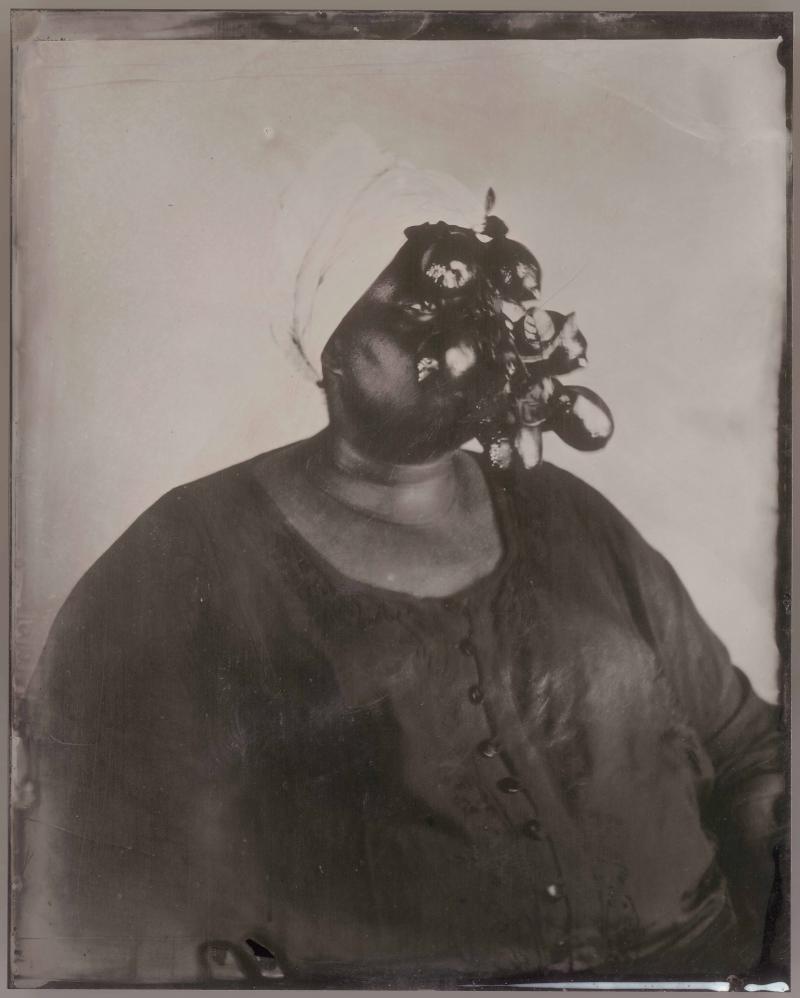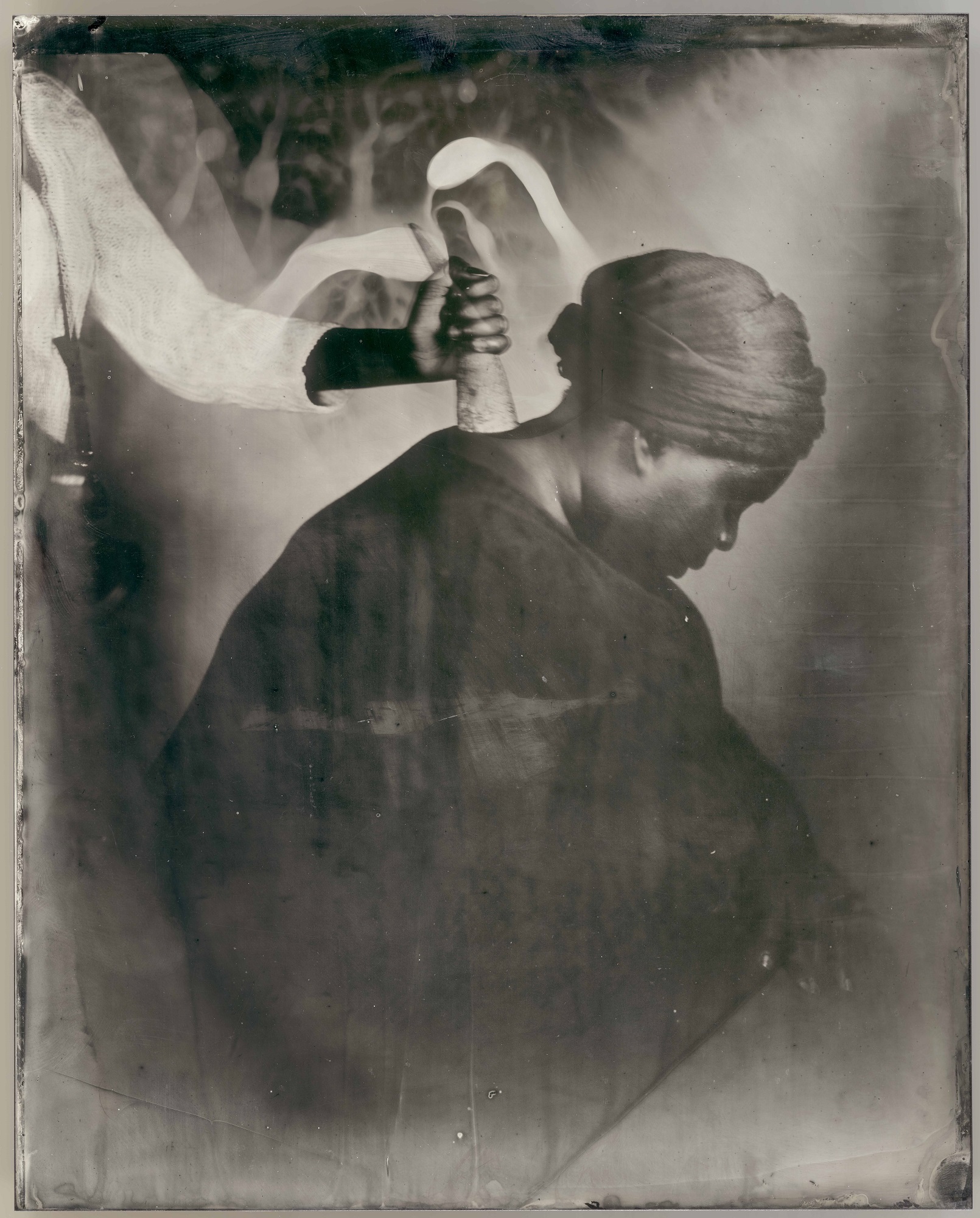Khadija Saye: In This Space We Breathe, 236 Westbourne Grove review - a celebrated series finds new resonance | reviews, news & interviews
Khadija Saye: In This Space We Breathe, 236 Westbourne Grove review - a celebrated series finds new resonance
Khadija Saye: In This Space We Breathe, 236 Westbourne Grove review - a celebrated series finds new resonance
The artist's most celebrated works launch a new public art project in west London

Khadija Saye was 24 when she died in the Grenfell Tower fire of 2017, the same year that her series of photographic self-portraits showed in the Diaspora Pavilion at the Venice Biennale: she was the youngest artist in a roster of well-established figures such as Joy Gregory and Isaac Julien.
Claiming prescience in art is tricky and probably ill-advised, but still it is true that in the aftermath of Grenfell, In This Space We Breathe directly addressed the outrage of that disaster, in which the right to live and breathe freely at home had been so flagrantly violated. Since then, the murder of George Floyd, and Covid 19 have forced us to confront the inequalities and prejudice suffocating BAME communities, and these events bring new resonance to Saye’s work, currently installed across the façade of 236 Westbourne Grove.
Though only six went to the Biennale, the complete series of nine photographs was produced specifically for the Diaspora Pavilion, a continuation of Saye’s exploration of her mixed faith, Gambian-British background. In each image, the artist is engaged in an aspect of traditional Gambian spiritual practice, the exact nature and significance of which is incomprehensible to anyone outside that tradition.
 Her chosen medium, the archaic process of wet collodion tintype is an inspired one, its characteristically ethereal, indistinct rendering emphasising the gulf of understanding that will for most viewers make these deeply meaningful rituals entirely meaningless (pictured right: Nak Bejjen, 2017). Redolent of 19th century imperialism, the distinctive aesthetic qualities of tintype place Saye’s self-portraits in a history of the depiction of black people, contributing to a narrative in which "primitive", "exotic" traditions and rituals have been used to justify their subjugation.
Her chosen medium, the archaic process of wet collodion tintype is an inspired one, its characteristically ethereal, indistinct rendering emphasising the gulf of understanding that will for most viewers make these deeply meaningful rituals entirely meaningless (pictured right: Nak Bejjen, 2017). Redolent of 19th century imperialism, the distinctive aesthetic qualities of tintype place Saye’s self-portraits in a history of the depiction of black people, contributing to a narrative in which "primitive", "exotic" traditions and rituals have been used to justify their subjugation.
Saye’s self-portraits move easily between the historical and universal to the personal, and the mood of each picture changes as she experiments with her cast of props. Sometimes, her eyes closed or averted, she seems to occupy some other persona or mental space; in Limoŋ (main picture), her face is obscured by what looks like a cluster of dark lemons, save for her right eye twinkling next to them, surely conspiratorially.
The challenge to decode props recalls much older traditions of portraiture, and the soft rendering of skin and fabric allows easy parallels with painting. In Toor-Toor, Saye’s direct gaze and decorative headdress recalls Rembrandt’s self-portraits, in which hats enable him to occupy a particular persona.
In This Space We Breathe launches Breath Is Invisible, a new public art project in Notting Hill set up by patron and businesswoman Eiesha Bharti Pasricha, and curated by Sigrid Kirk, to address the issues of social inequality and injustice laid bare by recent events. Later on this summer, Martyn Ware, Zachary Eastwood-Bloom and Joy Gregory will present new commissions created in partnership with the local community.
- Khadija Saye: In This Space We Breathe at 236 Westbourne Grove until 7 August
- breathisinvisible.com
- More visual arts reviews on theartsdesk
rating
Explore topics
Share this article
The future of Arts Journalism
You can stop theartsdesk.com closing!
We urgently need financing to survive. Our fundraising drive has thus far raised £49,000 but we need to reach £100,000 or we will be forced to close. Please contribute here: https://gofund.me/c3f6033d
And if you can forward this information to anyone who might assist, we’d be grateful.

Subscribe to theartsdesk.com
Thank you for continuing to read our work on theartsdesk.com. For unlimited access to every article in its entirety, including our archive of more than 15,000 pieces, we're asking for £5 per month or £40 per year. We feel it's a very good deal, and hope you do too.
To take a subscription now simply click here.
And if you're looking for that extra gift for a friend or family member, why not treat them to a theartsdesk.com gift subscription?
more Visual arts
 'We are bowled over!' Thank you for your messages of love and support
Much-appreciated words of commendation from readers and the cultural community
'We are bowled over!' Thank you for your messages of love and support
Much-appreciated words of commendation from readers and the cultural community
 Photo Oxford 2025 review - photography all over the town
At last, a UK festival that takes photography seriously
Photo Oxford 2025 review - photography all over the town
At last, a UK festival that takes photography seriously
![SEX MONEY RACE RELIGION [2016] by Gilbert and George. Installation shot of Gilbert & George 21ST CENTURY PICTURES Hayward Gallery](https://theartsdesk.com/sites/default/files/styles/thumbnail/public/mastimages/Gilbert%20%26%20George_%2021ST%20CENTURY%20PICTURES.%20SEX%20MONEY%20RACE%20RELIGION%20%5B2016%5D.%20Photo_%20Mark%20Blower.%20Courtesy%20of%20the%20Gilbert%20%26%20George%20and%20the%20Hayward%20Gallery._0.jpg?itok=7tVsLyR-) Gilbert & George, 21st Century Pictures, Hayward Gallery review - brash, bright and not so beautiful
The couple's coloured photomontages shout louder than ever, causing sensory overload
Gilbert & George, 21st Century Pictures, Hayward Gallery review - brash, bright and not so beautiful
The couple's coloured photomontages shout louder than ever, causing sensory overload
 Lee Miller, Tate Britain review - an extraordinary career that remains an enigma
Fashion photographer, artist or war reporter; will the real Lee Miller please step forward?
Lee Miller, Tate Britain review - an extraordinary career that remains an enigma
Fashion photographer, artist or war reporter; will the real Lee Miller please step forward?
 Kerry James Marshall: The Histories, Royal Academy review - a triumphant celebration of blackness
Room after room of glorious paintings
Kerry James Marshall: The Histories, Royal Academy review - a triumphant celebration of blackness
Room after room of glorious paintings
 Folkestone Triennial 2025 - landscape, seascape, art lovers' escape
Locally rooted festival brings home many but not all global concerns
Folkestone Triennial 2025 - landscape, seascape, art lovers' escape
Locally rooted festival brings home many but not all global concerns
 Sir Brian Clarke (1953-2025) - a personal tribute
Remembering an artist with a gift for the transcendent
Sir Brian Clarke (1953-2025) - a personal tribute
Remembering an artist with a gift for the transcendent
 Emily Kam Kngwarray, Tate Modern review - glimpses of another world
Pictures that are an affirmation of belonging
Emily Kam Kngwarray, Tate Modern review - glimpses of another world
Pictures that are an affirmation of belonging
 Kiefer / Van Gogh, Royal Academy review - a pairing of opposites
Small scale intensity meets large scale melodrama
Kiefer / Van Gogh, Royal Academy review - a pairing of opposites
Small scale intensity meets large scale melodrama
 Jenny Saville: The Anatomy of Painting, National Portrait Gallery review - a protégé losing her way
A brilliant painter in search of a worthwhile subject
Jenny Saville: The Anatomy of Painting, National Portrait Gallery review - a protégé losing her way
A brilliant painter in search of a worthwhile subject
 Abstract Erotic, Courtauld Gallery review - sculpture that is sensuous, funny and subversive
Testing the boundaries of good taste, and winning
Abstract Erotic, Courtauld Gallery review - sculpture that is sensuous, funny and subversive
Testing the boundaries of good taste, and winning
 Edward Burra, Tate Britain review - watercolour made mainstream
Social satire with a nasty bite
Edward Burra, Tate Britain review - watercolour made mainstream
Social satire with a nasty bite

Add comment